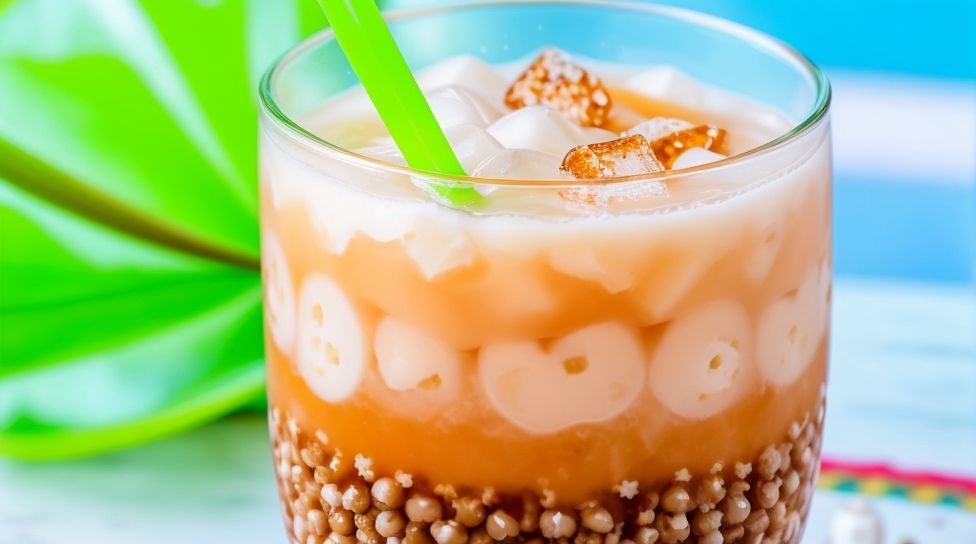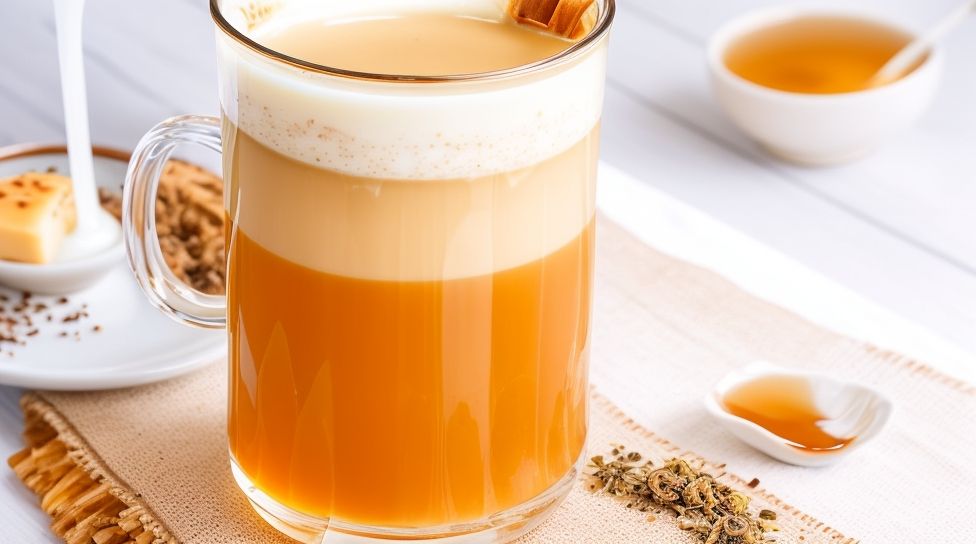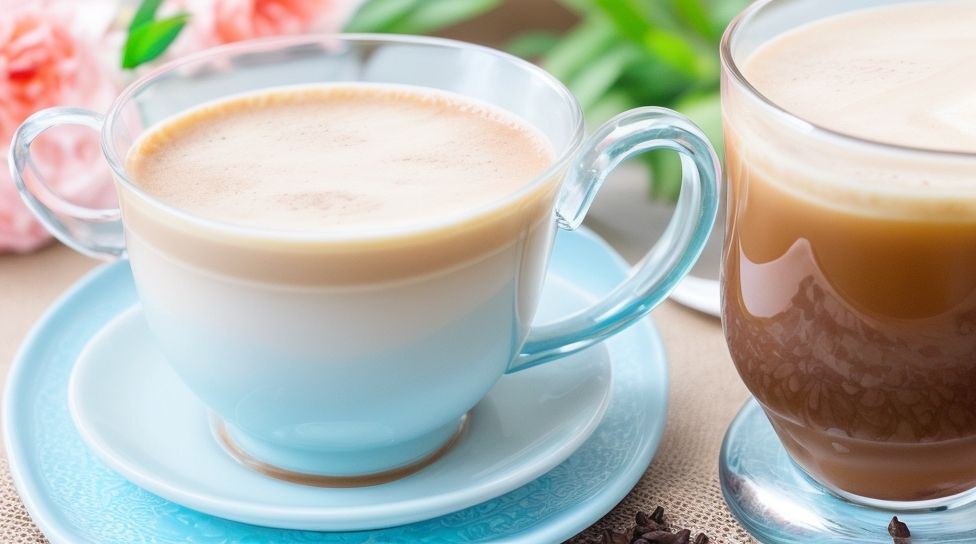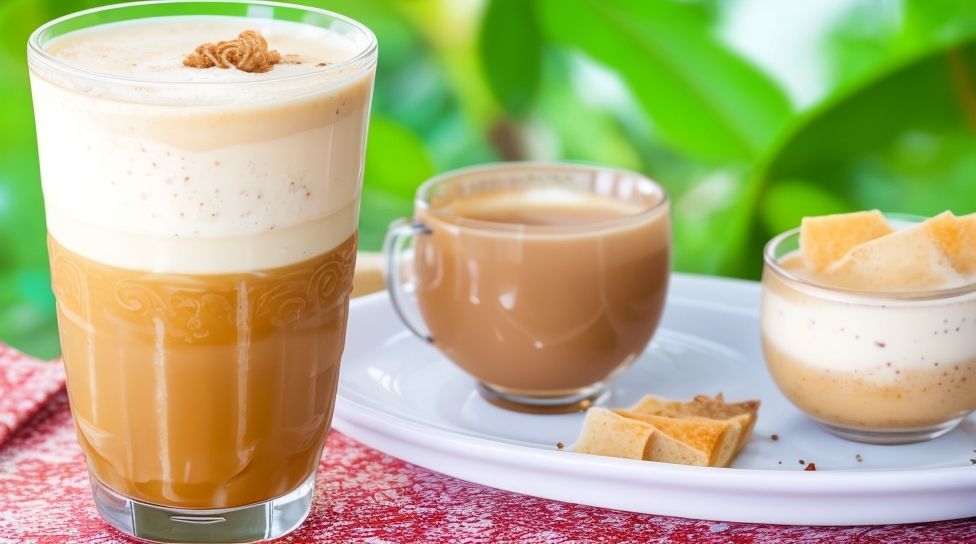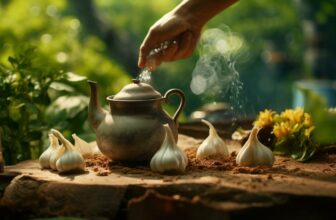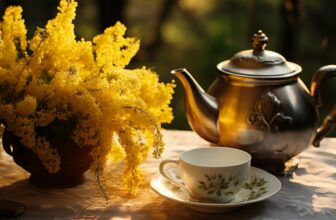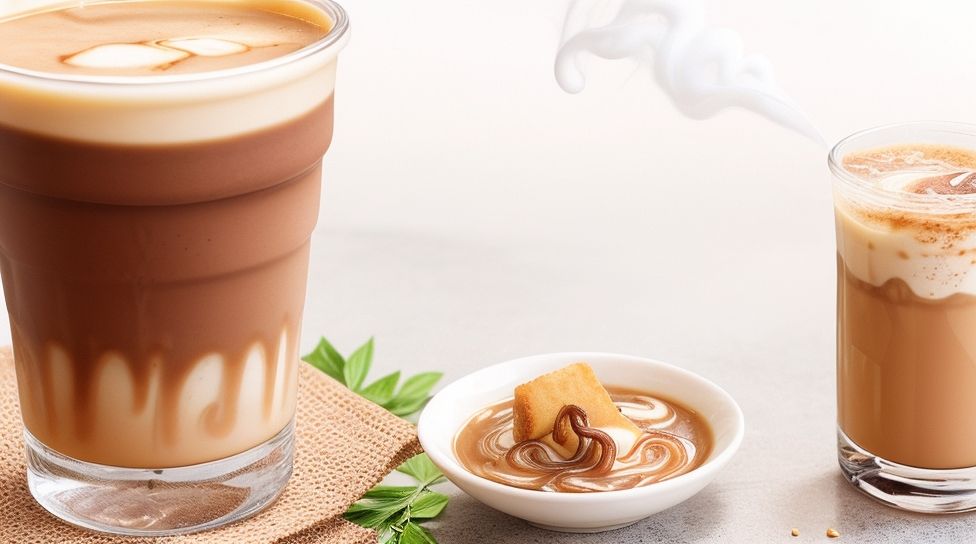
Milk tea, a popular beverage enjoyed by many across the globe, combines the richness of tea with the creaminess of milk. This delightful and refreshing drink has a fascinating history and offers various delicious variations. Let’s explore the world of milk tea!
1. Origins and History of Milk Tea:
Milk tea traces its roots back to the 19th century, with its origins often linked to British colonialism and the introduction of tea to regions like Hong Kong and India. Over time, milk tea has evolved and been adapted by different cultures, resulting in unique variations around the world.
2. Popular Variations of Milk Tea:
Throughout its history, milk tea has taken on different forms and flavors across various cultures. Some notable variations include the popular Hong Kong-style milk tea, Assam milk tea from India, Thai milk tea with its signature sweet and creamy taste, matcha milk tea that blends the distinct flavor of Japanese matcha with milk, and taro milk tea, which features the deliciously nutty and sweet flavor of taro root.
Types of Milk Tea:
1. Classic Milk Tea: The classic milk tea is commonly made with black tea leaves and sweetened condensed milk for a rich and creamy taste.
2. Assam Milk Tea: Assam milk tea originates from Assam, India, and is made using strong, malty Assam black tea combined with milk and sugar.
3. Thai Milk Tea: Thai milk tea is known for its vibrant orange color and delicious blend of strongly brewed Ceylon tea, condensed milk, and spices like star anise and cardamom.
4. Matcha Milk Tea: Matcha milk tea brings together the earthy and grassy flavors of high-quality powdered green tea with creamy milk for a unique and energizing beverage.
5. Taro Milk Tea: Taro milk tea incorporates the natural sweetness and unique flavor of mashed taro root, blended with black tea and milk.
Basic Milk Tea Recipe:
1. Ingredients Required: Tea leaves or tea bags, milk, sweetener (such as sugar or honey), and water.
2. Steps to Prepare: Brew a strong cup of tea, add milk and sweetener according to taste, stir well, and serve hot or over ice.
Variations and Customizations:
1. Adding Boba or Tapioca Pearls: For a fun and textural twist, add chewy boba or tapioca pearls to your milk tea.
2. Adding Fruit Syrups: Enh
Key takeaway:
- Milk tea is a versatile and delicious beverage: With its origins and variations from different cultures, milk tea offers a wide range of flavors and tastes.
- Customizations enhance the milk tea experience: Adding boba, fruit syrups, or exploring vegan and dairy-free options allows individuals to personalize their milk tea and create unique combinations.
- Tips and tricks for the perfect milk tea: Choosing the right tea leaves, adjusting sweetness levels, and experimenting with different types of milk can help achieve the desired flavor and consistency of milk tea.
What is Milk Tea?
Photo Credits: Www.Teamastershub.Com by Logan Walker
Milk tea, a delicious and beloved beverage, holds a fascinating history and a multitude of variations. By exploring its origins and delving into its popularity, we can uncover the captivating story of milk tea. From its humble beginnings to its diverse range of flavors, this section will take you on a mouthwatering journey through the world of milk tea. Get ready to sip, savor, and discover the delightful wonders of this timeless concoction.
Origins and History of Milk Tea
Origins and History of Milk Tea
Milk tea has an interesting and rich history that can be traced back to various cultures across the globe. This beloved beverage has undergone transformations over time and has now become a favorite choice among tea enthusiasts worldwide.
The origins of milk tea can be found in the British colonial period in India during the 19th century. It was at this time that the British introduced tea to the Indian subcontinent. The practice of adding milk to tea originated from Indian culture, and the British adopted this tradition, giving birth to what we now know as milk tea.
In the 1980s, milk tea gained popularity in the lively tea shops of Taiwan. It was in Taiwan where the idea of incorporating different flavors and ingredients, such as tapioca pearls or boba, was introduced. This brought an innovative and fresh twist to traditional milk tea.
Today, milk tea has become a global sensation, with each culture and region adding its unique touch to this beverage. From the creamy and indulgent Thai milk tea to the bold and vibrant matcha milk tea of Japan, there is a vast array of milk tea variations to cater to diverse taste preferences.
The origins and history of milk tea reveal its cultural significance and how it has evolved into a beloved and versatile drink cherished by people all over the world.
Popular Variations of Milk Tea
| 1. Classic Milk Tea | A traditional and timeless favorite, made with black tea and sweetened condensed milk. |
| 2. Assam Milk Tea | A variant that uses Assam tea leaves, known for its strong and malty flavor. |
| 3. Thai Milk Tea | A popular Thai version made with strongly brewed Ceylon tea, sweetened condensed milk, and often served over ice. |
| 4. Matcha Milk Tea | A modern twist that combines the earthy flavors of matcha green tea with the creaminess of milk. |
| 5. Taro Milk Tea | A unique variation that incorporates taro root, creating a slightly sweet and nutty flavor. |
Each of these Popular Variations of Milk Tea offers a distinct taste and appeal to different preferences. The classic milk tea is a safe choice for those who enjoy a traditional flavor. Assam milk tea is ideal for those who prefer a stronger and more robust taste. Thai milk tea provides a delightful blend of tea and sweetness, perfect for hot summer days. Matcha milk tea appeals to those who appreciate the unique taste of matcha and enjoy its health benefits. Taro milk tea offers a unique and slightly exotic flavor profile, making it a favorite among adventurous tea lovers. Feel free to experiment with these variations, adding your own twists and customizations to create the perfect milk tea that suits your taste.
Types of Milk Tea: Exploring the eclectic world of milk tea, from classic to exotic flavors, so you can sip your way through like a tea connoisseur with a lactose-loving heart.
Types of Milk Tea
Photo Credits: Www.Teamastershub.Com by Walter Smith
Explore the world of milk tea with an array of delightful flavors. In this section, we will dive into the various types of milk tea that will satisfy your taste buds. From the classic milk tea to the rich and robust Assam milk tea, and the aromatic Thai milk tea, to the earthy and vibrant matcha milk tea, and the exotic taro milk tea, there’s a flavor for everyone to indulge in. Get ready to embark on a milk tea journey like no other!
Classic Milk Tea
Classic Milk Tea is a beloved and popular variation of milk tea enjoyed by many. Here are some key details about this delightful beverage:
- Ingredients: Classic Milk Tea typically contains black tea, milk, sugar, and sometimes a touch of vanilla for added flavor.
- Preparation: To make Classic Milk Tea, start by brewing a strong cup of black tea. Then, heat milk and mix it with the brewed tea. Add sugar to taste and stir until dissolved. Optionally, you can also add a splash of vanilla extract for a hint of extra flavor.
- Flavor profile: The combination of robust black tea, creamy milk, and sweetness create a rich and comforting flavor profile in Classic Milk Tea. The tea flavor shines through while being balanced by the creamy and sweet elements.
- Customizations: Classic Milk Tea can be customized to suit individual preferences. Some common variations include adding boba or tapioca pearls for a fun texture, adding fruit syrups for fruity twists, or using vegan and dairy-free alternatives for those with dietary restrictions.
- Enjoyment: Classic Milk Tea is often enjoyed hot but can also be served over ice for a refreshing cold beverage. It is perfect for cozy mornings, afternoon pick-me-ups, or as a tasty treat any time of the day.
Assam Milk Tea
is a popular variation of milk tea that originated in the Assam region of India. Here are some key facts and considerations about
- Strong and Robust Flavor: Assam Milk Tea is known for its strong and robust flavor. It is made using Assam tea leaves, which have a distinct malty taste. The bold flavor of Assam tea adds depth and richness to the milk tea.
- Assam Tea Leaves: Assam Milk Tea is made using Assam tea leaves, which are grown in the fertile plains of Assam, India. These tea leaves are known for their full-bodied flavor and high caffeine content.
- Traditional Preparation: Assam Milk Tea is traditionally prepared by brewing the Assam tea leaves in hot water and then adding milk and sweetener to taste. The tea is simmered to infuse the flavors and create a comforting beverage.
- Perfect Blend with Milk: The strong flavor of Assam tea pairs perfectly with milk, creating a creamy and satisfying drink. The milk helps to balance the boldness of the tea and adds a smooth and velvety texture to the beverage.
- Customize to Taste: Like any other milk tea, Assam Milk Tea can be customized to suit individual preferences. You can adjust the sweetness level, add flavors like vanilla or cardamom, or even top it with boba pearls for a fun twist.
For those who enjoy a strong and bold tea flavor in their milk tea, Assam Milk Tea is a great option. Its rich and robust taste, along with the creamy texture from the milk, makes it a delightful beverage choice. So, go ahead and savor the unique flavors of Assam Milk Tea today!
Get ready for a taste of Thailand with Thai Milk Tea – it’s like a vacation in every sip, without the expensive plane ticket.
Thai Milk Tea
is a popular variation of milk tea that originates from Thailand, also known as “cha yen” in Thai. It has a unique flavor and is loved for its rich, creamy, and sweet taste. Here is a table describing the main ingredients used in
| Ingredient | Quantity |
| Black tea leaves | 2 tablespoons |
| Water | 1 cup |
| Condensed milk | 2-3 tablespoons |
| Evaporated milk | 2-3 tablespoons |
| Sugar | 1-2 tablespoons, or to taste |
To prepare Thai Milk Tea, follow these steps:
- Boil water and add tea leaves. Let it steep for about 5 minutes.
- Strain the tea leaves and let the tea cool down.
- Add condensed milk, evaporated milk, and sugar to the tea. Stir well until everything is combined and the sugar is dissolved.
- Pour the Thai Milk Tea over ice and serve.
Thai Milk Tea is known for its vibrant orange color, which is achieved by using a special ingredient called “Nam Dok Anchan” or butterfly pea flowers. These flowers give the tea its distinct hue. Thai Milk Tea is a flavorful and refreshing beverage that is perfect for enjoying on a hot day.
Fact: Thai Milk Tea is often served with a straw and is sometimes garnished with a sprig of mint for added freshness.
Matcha Milk Tea
- Matcha Milk Tea is a delicious and popular variation of milk tea.
- It is made using powdered matcha green tea, which gives it a vibrant green color and a unique flavor.
- Matcha is known for its health benefits, as it is rich in antioxidants and provides a natural energy boost.
- To make Matcha Milk Tea, start by whisking a small amount of matcha powder with hot water to create a smooth paste.
- Then, add your desired amount of sweetener, such as honey or sugar, and stir until dissolved.
- Pour in warm milk (or a dairy-free alternative) and mix well to create a creamy and frothy beverage.
Historically, matcha has been an important part of Japanese tea ceremonies dating back to the 12th century. The tea leaves are grown in shaded conditions, which enhances their chlorophyll content and gives matcha its vibrant green color. Matcha is meticulously ground into a fine powder, ensuring that you consume the entire leaf, maximizing its benefits. Its distinct flavor and unique preparation method make Matcha Milk Tea a beloved choice among tea enthusiasts. So, next time you’re craving a refreshing and energizing drink, give Matcha Milk Tea a try!
Taro Milk Tea
- Taro milk tea is a beloved variation of milk tea known for its unique flavor and delightful purple color.
- It is created by infusing taro root into the milk tea mixture, providing a creamy and slightly sweet taste.
- Taro milk tea can be savored either hot or cold, depending on personal preference.
- It is commonly garnished with boba pearls or tapioca pearls, enhancing the drink with an enjoyable texture.
- To prepare taro milk tea, gather taro powder or fresh taro, black tea, milk, sugar, and ice (if desiring a cold drink).
- Commence by boiling taro root until it reaches a soft consistency, then transform it into either a paste or powder.
- Brew black tea and allow it to cool, then mix it with the taro paste or powder.
- Add milk and sugar to your liking, and stir until thoroughly combined.
- If serving cold, pour the mixture over a glass filled with ice.
- For an extra touch, consider adding boba pearls or tapioca pearls to your drink to introduce a delightful chewiness.
- Indulge in the delectable and distinct flavor that taro milk tea brings!
Get ready to brew the perfect milk tea with this simple recipe that will have you ditching your daily coffee.
Basic Milk Tea Recipe
Photo Credits: Www.Teamastershub.Com by Raymond Thomas
Looking to create the perfect cup of milk tea? Look no further! In this section, we will be exploring the essential elements of a basic milk tea recipe. From the necessary ingredients to the step-by-step process, we’ll uncover the secrets to preparing a delightful cup of milk tea that will surely satisfy your cravings. So, grab your teapot and get ready to embark on a delicious journey into the world of milk tea making.
Ingredients Required
To provide clarity on the ingredients required to make milk tea, please refer to the table below:
| Tea Leaves |
| Milk |
| Sugar |
| Water |
| Ice Cubes (optional) |
| Toppings (e.g. boba or tapioca pearls, fruit syrups, etc.) |
These are the fundamental ingredients needed to prepare milk tea. You will require tea leaves to infuse the flavor into the drink. Milk is necessary for achieving a creamy and smooth texture. Sugar can be added to enhance the sweetness of the tea. Water is used to brew the tea leaves and create the base of the drink. Adding ice cubes can help make it a refreshing cold beverage. Toppings such as boba or tapioca pearls, as well as fruit syrups, can be included to incorporate additional flavor and texture.
It is important to note that the specific measurements of these ingredients may vary depending on personal preferences. Experimenting with different quantities and ratios will help you find your preferred taste.
The next step to becoming a milk tea master is mastering the art of preparation, so get ready to stir, steep, and sip your way to greatness.
Steps to Prepare
- To prepare a delicious milk tea, follow these steps:
- Boil water in a pot or kettle.
- Add tea leaves or tea bags to a teapot or cup. Use approximately 1 teaspoon of loose tea leaves or 1 tea bag per serving.
- Pour the hot water over the tea leaves or tea bags and steep for 3 to 5 minutes, depending on desired strength.
- While the tea is steeping, heat milk in a separate saucepan or microwave until hot but not boiling.
- Once the tea has steeped, remove the tea leaves or tea bags and discard them.
- Pour the hot milk into the cup or teapot with the brewed tea.
- Add sweetener, such as sugar or honey, to taste. Stir well to dissolve.
- If desired, add any additional flavorings like vanilla extract or spices such as cinnamon or cardamom.
- For a creamier texture, you can also add a tablespoon of condensed milk or evaporated milk.
- Give the milk tea a final stir and serve hot.
By following these steps to prepare, you can easily prepare a comforting and satisfying cup of milk tea at home. Enjoy!
Spice up your milk tea game with boba, syrups, and dairy-free options – customize your way to milky bliss!
Variations and Customizations
Photo Credits: Www.Teamastershub.Com by Bruce Flores
Looking to add some pizzazz to your milk tea? In this section, we’ll dive into the exciting world of variations and customizations. From adding boba or tapioca pearls for a fun twist to experimenting with fruit syrups for a burst of fruity goodness, we’ll explore all the unique ways you can elevate your milk tea experience. Plus, for those with dietary restrictions, we’ve got you covered with our exploration of vegan and dairy-free alternatives. Get ready to discover a world of endless possibilities for your milk tea concoctions!
Adding Boba or Tapioca Pearls
When preparing milk tea, one delicious twist is to incorporate boba or tapioca pearls into the mixture, enhancing both its texture and flavor. Boba pearls are small, chewy balls made from tapioca starch, which are typically cooked in a sweet syrup before being added to the tea.
To seamlessly include boba or tapioca pearls in your milk tea, just follow these simple steps:
1. Prepare the boba pearls: Begin by cooking the boba pearls according to the instructions on the package. Usually, this entails boiling them in water until they become soft and chewy. Then, let them soak in a sweet syrup to infuse even more delightful flavor.
2. Brew the tea: While the boba pearls are cooking, brew your desired type of tea to perfection. Whether you prefer black tea, green tea, or any other variety, ensure that its strength complements the sweetness of the boba pearls.
3. Sweeten the tea: Once the tea is properly brewed, gently stir in your preferred sweetener until the taste is just right. You can opt for sugar, honey, or any other sweetener that suits your palate. Adjust the level of sweetness according to your personal preference.
4. Incorporate the boba pearls: After the boba pearls have finished cooking and indulging in the sweet syrup, drain them and generously add them to your prepared tea. As you enjoy your drink, conveniently scoop up the pearls with a spoon or sip them up through a straw.
By introducing boba or tapioca pearls into your milk tea, you can elevate your beverage with an enjoyable chewy texture and a burst of sweetness in every sip. This addition brings an extra touch of excitement to your drink and is particularly popular among milk tea aficionados.
Adding Fruit Syrups
When it comes to adding fruit syrups to your milk tea, there are a variety of options to choose from to enhance the flavor and add a touch of sweetness. Here are some suggestions:
| Strawberry syrup: Adding a few teaspoons of strawberry syrup to your milk tea can give it a refreshing and fruity taste. It pairs well with black tea or green tea-based milk teas. |
| Mango syrup: For a tropical twist, try incorporating mango syrup into your milk tea. It adds a sweet and tangy flavor that complements the creaminess of the milk. |
| Peach syrup: If you prefer a milder and slightly floral taste, consider using peach syrup. It adds a subtle sweetness to your milk tea without overpowering the other flavors. |
| Blueberry syrup: To give your milk tea a burst of berry flavor, try including blueberry syrup. It adds a rich and slightly tart taste that can make your drink more vibrant. |
| Passion fruit syrup: If you want to add a tropical and exotic flavor to your milk tea, opt for passion fruit syrup. It adds a sweet and tangy taste that can be a refreshing twist. |
Experimenting with different fruit syrups can help you discover your favorite flavor combinations. Whether you prefer classic combinations like strawberry or more unique options like passion fruit, incorporating fruit syrups can take your milk tea to the next level.
Who needs dairy when you can have a guilt-free sip of vegan bliss in milk tea?
Vegan and Dairy-Free Alternatives
- Vegan and dairy-free alternatives: When making milk tea, you have a variety of options to choose from that are both vegan and dairy-free. Plant-based milks like almond milk, soy milk, coconut milk, and oat milk are great choices. These milks are made from natural ingredients and will give your milk tea a creamy texture and flavor.
- Non-dairy creamers: Another excellent choice for dairy-free milk tea is non-dairy creamers. These creamers are made using ingredients such as coconut oil, tapioca starch, and flavorings. They add a rich and creamy consistency to your milk tea.
- Fruit juices: For a refreshing twist, you can replace milk with various fruit juices. Pineapple juice, mango juice, or strawberry juice can be used to create a fruity milk tea. These alternatives offer a lighter and tangy flavor to your beverage.
- Herbal infusions: Instead of traditional tea leaves, consider using herbal infusions like chamomile, peppermint, or rooibos for your milk tea. These infusions are caffeine-free and have distinctive flavors that blend well with other ingredients.
- Mix of alternatives: Get creative and experiment with different combinations of vegan and dairy-free alternatives to make your customized milk tea. For example, you can try blending almond milk and coconut milk to achieve a unique flavor profile.
By exploring these vegan and dairy-free alternatives, you can enjoy delicious milk tea that caters to your dietary preferences or restrictions. Remember to adjust the ratios and sweetness levels according to your taste.
Spill the tea (with milk) and let me teach you the tricks for the perfect cup of milk tea.
Tips and Tricks for the Perfect Milk Tea
Photo Credits: Www.Teamastershub.Com by Joseph Robinson
Want to create the perfect cup of milk tea? Look no further! In this section, we’ll uncover some amazing tips and tricks that will elevate your milk tea game to the next level. Discover the secrets behind choosing the right tea leaves, finding your ideal sweetness level, and even experimenting with different types of milk. Get ready to sip on the most delicious and satisfying milk tea you’ve ever tasted. Let’s dive in!
Choosing the Right Tea Leaves
Choosing the Right Tea Leaves for Making Delicious Milk Tea
When it comes to making a perfect cup of milk tea, the choice of tea leaves plays a vital role. Here are some key factors that you should consider:
| Quality | It is essential to select high-quality tea leaves. Look for leaves that are whole, not broken, and emit a fresh aroma. |
| Type | Decide which type of tea you prefer. You have various options including black tea, green tea, and oolong tea. Each type possesses its own unique flavor profile. |
| Origin | Take into account the origin of the tea leaves. Different regions produce teas with distinct characteristics. For instance, India’s Assam tea boasts a rich, malty flavor, while Darjeeling tea offers a floral and muscatel taste. |
| Blend or Single Origin | You can choose between blended tea leaves or tea leaves from a single origin. Blends provide a balanced flavor, while single-origin teas offer a more distinct taste. |
| Caffeine Content | Consider the caffeine content of the tea leaves. If you seek a stronger pick-me-up, opt for black tea with higher caffeine levels. For a milder option, go for green or white tea instead. |
| Personal Preference | Ultimately, select tea leaves that align with your personal taste preferences. Feel free to experiment with different varieties to discover your favorite flavor combination for milk tea. |
By taking these factors into consideration and choosing the right tea leaves, you can enhance the taste and enjoyment of your homemade milk tea.
Sweet or not, that is the tea-stion when it comes to adjusting the sweetness level of your milk tea.
Adjusting the Sweetness Level
To fine-tune the sweetness level of your milk tea, follow these simple steps:
- Begin with the recommended amount of sweetener: Kick-start by incorporating the suggested quantity of sweetener based on the recipe you are using. This could be sugar, honey, or any other favored sweetener.
- Evaluate and gauge: Once you’ve added the initial dose of sweetener, go ahead and taste your milk tea. Assess whether the sweetness level meets your preference or if it requires some adjustment.
- Gradually introduce more sweetener: If you discover that the milk tea lacks sufficient sweetness, progressively incorporate additional sweetener in small portions. After each addition, stir well and taste again to verify if the desired level of sweetness has been achieved.
- Reduce sweetness by adding milk or water: In case your milk tea becomes overly sweet, restore harmony by introducing more milk or water. This will even out the flavors and diminish the overall sweetness.
- Personalize according to your taste: Bear in mind that everyone’s sweetness preferences differ. Modify the sweetness level to align with your personal taste. You might prefer a less sugary milk tea or an intensified level of sweetness.
By following these steps, you can attain the ideal sweetness level for your milk tea. Experiment with varying amounts of sweetener until you discover the perfect balance that suits your palate. Adjusting the sweetness level permits you to tailor your milk tea experience to your liking.
Experimenting with Different Milk Types
To fully explore the diverse flavors of milk tea, it is crucial to experiment with various types of milk. Below, you will find a convenient table listing some popular milk types commonly used in milk tea, along with their distinctive characteristics:
| Milk Type | Description |
|---|---|
| Whole Milk | Rich and creamy, enhancing the tea flavor |
| Almond Milk | Nutty and slightly sweet |
| Coconut Milk | Creamy and tropical |
| Soy Milk | Creamy with a hint of nuttiness |
| Oat Milk | Creamy and slightly sweet |
Each milk type brings its own unique taste and texture to the milk tea experience. By engaging in the process of experimenting with different milk types, you have the ability to customize your milk tea to perfectly suit your preferences. Whether you favor a fuller flavor with whole milk or desire a nutty twist with almond milk, the act of exploring diverse milk types can take your milk tea experience to exciting new levels.
History reveals that the practice of incorporating various types of milk into beverages dates back centuries. In ancient times, people would combine milk with different ingredients to craft refreshing and nourishing drinks. This tradition remains alive today, with milk tea being savored in various regions across the globe, each incorporating its own unique variations and employment of diverse milk types. Therefore, I encourage you to embrace the spirit of experimentation to discover your own favorite milk and tea combination in your next cup of milk tea.
Some Facts About Milk Tea Recipe:
- ✅ Bubble tea, also known as boba, is a popular Taiwanese drink that combines black tea, milk, ice, and chewy tapioca pearls.
- ✅ The exact origin of bubble tea is unclear, with various stories claiming different teahouses in Taiwan during the 1980s as the birthplace.
- ✅ The inspiration for bubble tea comes from the use of tapioca pearls in Taiwanese snacks and the tradition of serving cold tea with milk and sugar in Taiwan.
- ✅ Bubble tea comes in a wide variety of flavors and can include fruit juices, fruit milk, coffee, and salted cream. There are also various toppings available, such as sago, taro balls, egg pudding, popping pearls, and jelly.
- ✅ Making bubble tea at home has several advantages, including avoiding harmful ingredients found in store-bought versions, saving money, and having more control over the flavor and calorie count.
Frequently Asked Questions
1. How long does it take to cook the boba pearls?
The boba pearls should be cooked for about 20 minutes until they are cooked through.
2. Can I use plain tea instead of black tea for the boba milk tea?
Yes, you can use other types of tea such as jasmine tea or a brewed black tea blend for a different flavor profile.
3. What is the purpose of the brown sugar syrup in the boba milk tea?
The brown sugar syrup adds sweetness and a distinct flavor to the boba pearls, enhancing the overall taste of the drink.
4. How can I make the milk mixture for the boba milk tea?
The milk mixture is made by whisking together half-and-half and sweetened condensed milk to create a creamy and rich texture.
5. Can I customize the boba milk tea with different toppings and flavors?
Yes, you can add different toppings such as tapioca balls, taro balls, or konjac jelly. You can also experiment with fruit flavors or add a coffee jelly for a unique twist.
6. Is it possible to make a less sweet version of the boba milk tea?
Yes, you can adjust the sweetness to your preference by reducing the amount of brown sugar syrup or using a less sweetened tea blend.
